Greenlanders would call the Hatch Cove Kayak—the newest design from David Wyman—a qajariaq, a “kayak-like” boat. Noted designer L. Francis Herreshoff would have called it a “double-paddle canoe.” But perhaps the best description for us might be a recreational touring kayak or “RTK.”
I first paddled (all too briefly) David’s prototype of the design just after he launched it in 2023. I brought with me the skepticism of decades of being a hard-core sea-kayak paddler and whitewater racer, to say nothing of my experiences of building and paddling skin-on-frame Inuit kayaks. I was (and still am, I suspect) a kayak snob: if it wasn’t long and skinny, and capable of being rolled, I wasn’t really interested.
David Wyman is a naval architect and boatbuilder who, for many years, was professor of naval architecture at Maine Maritime Academy, and is well known for his work with traditional sailing vessels. His personal boats range from small oar-and-sail cruisers to peapods and skiffs. He’d purchased some off-the-shelf small RTK’s to play with on ponds and rivers and to poke around in the waters near his home in Castine, Maine. But, never entirely satisfied, he decided to design one for his own use and to work with Clint Chase of Chase Small Craft to cut the parts for assembly in David’s home shop.
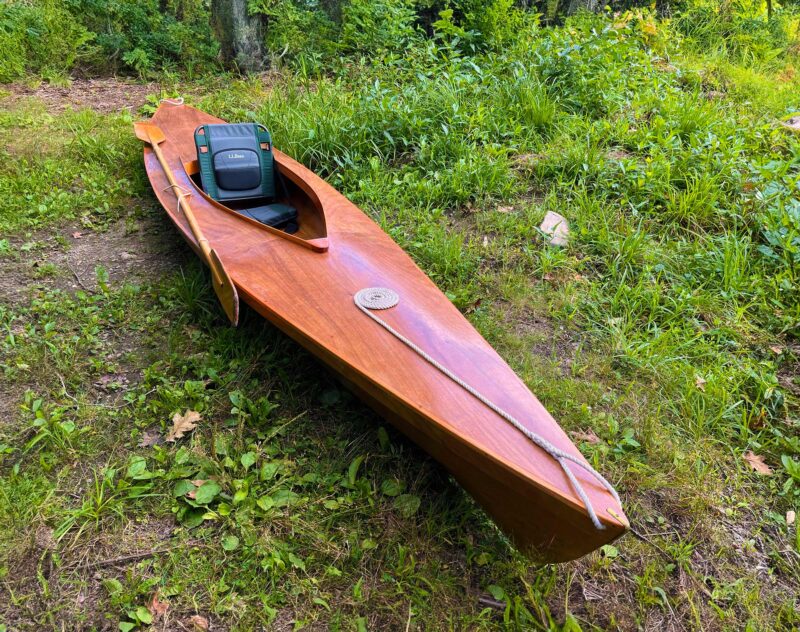 Ben Fuller
Ben FullerThe choice of seat is left to the individual. David uses an upright canoe seat from L.L.Bean, but a foam seat with back band would serve as well. He created a “paddle park” by feeding a bungee through the deck to loop over the paddle to a simple hook. The arrangement holds the paddle when transporting the boat; David also uses it on the water when he wants to take a break from paddling.
David’s basic requirement was that he could solo the new boat in and out of the back of his pickup, and then could easily get in and out of it. David is a pretty big guy and has the stiffness that so many of us have when we enter our fourth quarter-century. The boat’s overall weight needed to be under 50 lbs, it must be short enough to ride in a pickup, even if overhanging the back, and it had to have enough initial stability to be boarded dry-shod from a bank.
Then there were David’s on-water requirements: he wanted the boat to have some decking to help keep things dry in a chop, but not to suffer from the typical windage he’d experienced in the RTKs he’d been paddling. It must have enough buoyancy to float him and his cargo (he wanted to be able to carry camping gear), and he had a target smooth-water speed of 3 to 4 knots. It also had to track well and, with wind on the beam, hold a straight course without weathercocking.
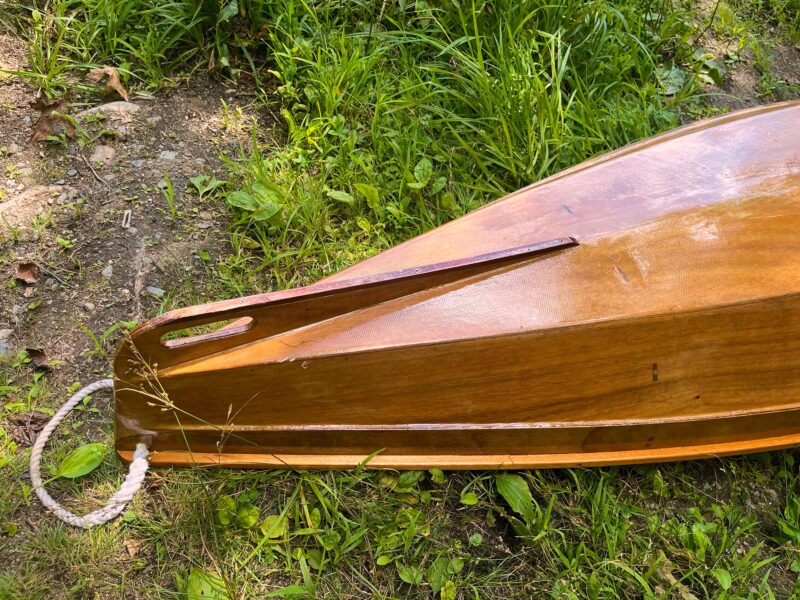 Ben Fuller
Ben FullerThe hand-hold in the skeg is useful when moving the kayak around on land; it may also contribute to the boat’s maneuverability in turns. Forward of the skeg can be seen the tabs that locate the after bulkhead—the tabs are integral to Chase Small Craft’s Tab-n-Lock construction system.
Working with Clint, David designed the boat so the parts could be cut on a CNC machine. It is built over four molds that are tabbed into precut slots in the boat’s bottom using Clint’s Tab-n-Lock system; once construction is complete, the molds remain in the boat as integral frames. There are three planks of 4mm okoume plywood on 6mm frames with select spruce coamings and hardwood trim. The 4mm plywood is strong, but thin enough to accommodate the twist in the sharp bow and stern. For extra strength, in the cockpit area, there is a second layer of 4mm plywood to reinforce the bottom planks. In the ends of the boat, watertight bulkheads provide buoyancy chambers fore and aft that are enough to float the boat and its payload. These are in lieu of larger bulkheads, set at either end of the cockpit to create cargo compartments with hatches on deck. David will carry his camping kit in dry bags stowed under the decks in front of and behind the cockpit. If one prefers camping gear to fit through deck hatches, the frames closest to the cockpit could be cut not as ring frames but solid, to serve as watertight bulkheads. Hatches for access could be cut into the deck or the bulkheads themselves.
When I was invited to revisit David and his prototype Hatch Cove a month or so ago, I was excited to take it out for a serious spin on a local lake. I used an adjustable-length conventional paddle set at 220cm. The prototype doesn’t have adjustable foot braces and since I’m a good bit shorter than David, we improvised a temporary brace with a block of 4×4 set against the forward ring frame. David has been using a simple high-back canoe seat from L.L.Bean. I am more familiar with foam seats and low back bands so was expecting to be uncomfortable but, once out paddling, I was impressed by the seat: it allowed me to execute a full body twist as if I were in a racing seat more typical of sprint kayaks. For people who want a secured seat, a foam seat and a back band could be fitted. Clint Chase recommends seats as sold by Newfound Woodworks.
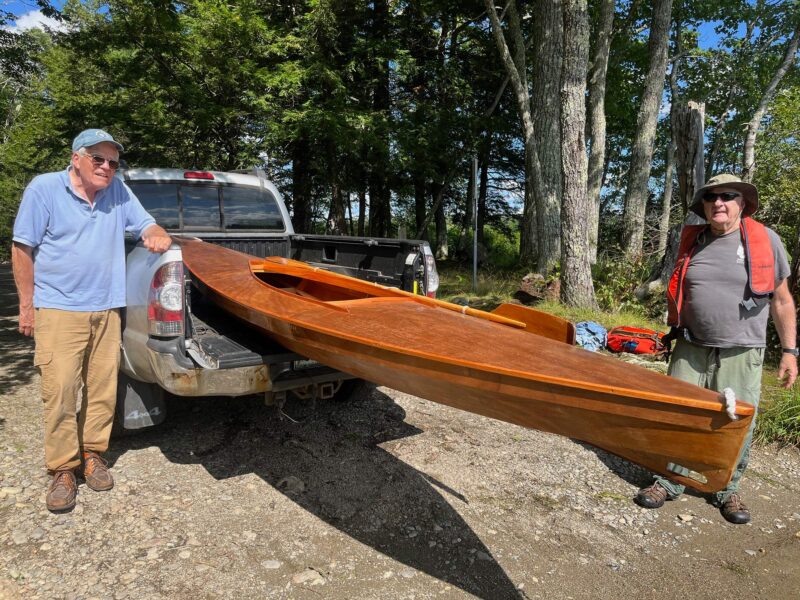 Ben Fuller
Ben FullerDavid Wyman (seen here, left, with photographer Harvey Bell) designed the Hatch Cove Kayak so he could lift it into and out of his pickup on his own. With the tailgate down, 8′ of the boat is supported by the truck, while the remaining 5′ overhangs. David lashes the boat in place and ties a red flag to the stern for transport.
To get into the kayak, I used the paddle as a brace to the shore and just stepped into the center and sat down, dry-shod. David carries a short stick and uses it as a cane in shallow water to help steady the boat and himself when climbing aboard; once on board, he stows the cane in his bungee paddle carrier. Getting out of the boat, I couldn’t reach the forward edge of the long cockpit, so I did what David does: I grabbed hold of the painter, pulled myself up to stand, and stepped out.
It was easy to paddle the Hatch Cove Kayak at 3 knots, and to get to 3.5 knots and 3.7 knots with just a little added pressure. In a flat-out sprint I could hit 4 knots briefly, but the kayak’s waterline length isn’t meant to go that fast. There wasn’t much wind, so I was unable to see if the boat weathercocked in a cross wind, but in the light breeze it was unaffected. David has tried the boat in a variety of conditions and reports that it tracked straight in as much wind as he cared to paddle: a nice 10 to 12 knots of breeze with a distinct surface chop.
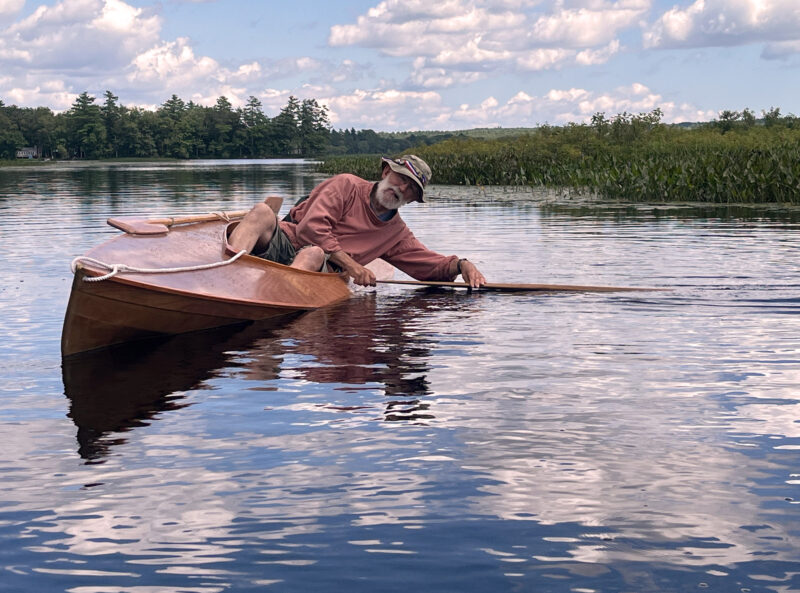 Harvey Bell
Harvey BellI leaned well over to test the stability of the kayak. Even with my head over the sheer, the water was still a few inches from the cockpit coaming. At this point I was applying no pressure on the Greenland paddle. To heel the boat any farther would have taken considerable effort.
To give the kayak innate tracking ability, David designed a sharp stern with a skeg. The skeg incorporates a generous hole so that it doubles as a carrying handle. But that hole may well contribute to the boat’s maneuverability. I had anticipated that it might be hard to spin with that sharp stern, but it wasn’t. I could spin the boat through 360 degrees with four pairs of sweep/reverse-sweep strokes—about the same as spinning a much longer sea kayak.
The boat has a slight V-bottom and a relatively long straight bow. The sheerstrakes overlap the middle strakes, to work as a spray rail, and David says it works well to keep spray down when paddling into a chop. I would also want a spray skirt—mostly to keep the paddle drip out of my lap—which would require a lip to be glued to the top of the coaming.
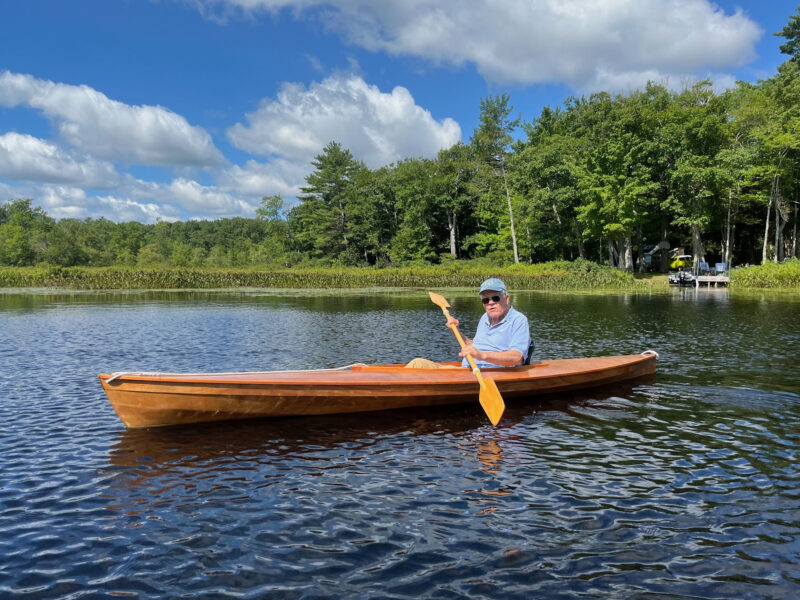 Ben Fuller
Ben FullerDavid Wyman (seen here in his Hatch Cove Kayak prototype), has designed a boat that is easily transported, easy to get into and out of, can carry him and his camp-cruising gear, and can reach smooth-water speeds of 3 to 4 knots.
The deck at the sides of the coaming is quite wide. My knees stuck up above the coaming and my lower legs braced against it comfortably. This allowed me to heel the boat to steer it— heeling down on the side opposite the direction that I wanted the boat to go.
I wanted to see how stable the boat felt when I shifted my weight out to the side. I could put my head and shoulders over the sheer and the coaming came within a few inches of the water. It would take real work to capsize. I did not get a chance to see what it was like fully swamped and whether I could bail it out but am confident that it would float me.
As a nimble, light, recreational touring kayak, this is as nice as anything I’ve seen on the market. For fishing, photography, working down a narrow creek, or exploring twisty saltwater coves or marshes, it’s ideal. And, it can cover miles when pushed.![]()
Ben Fuller, curator emeritus of the Penobscot Marine Museum in Searsport, Maine, has been messing about in small boats for a very long time. He is owned by a dozen or more boats: kayaks, canoes, a skiff, a ducker, and a sail-and-oar boat.
Hatch Cove Kayak Particulars
LOA: 13′ 8″
LWL: 12′ 11″
Beam: 32″
Draft: 4″
Depth amidships: 12″
Bare hull: 45 lbs
Capacity: 300 lbs
The Hatch Cove Kayak is available from Chase Small Craft; the complete kit is priced at $1,787.
Is there a boat you’d like to know more about? Have you built one that you think other Small Boats readers would enjoy? Please email us your suggestions.
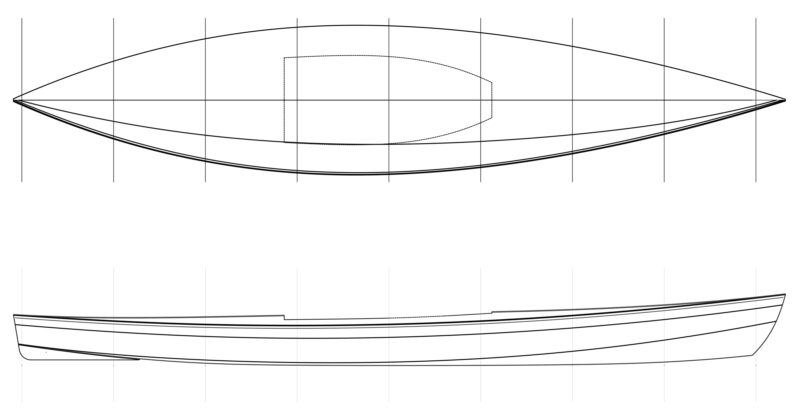
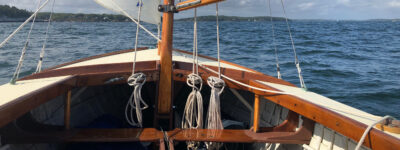
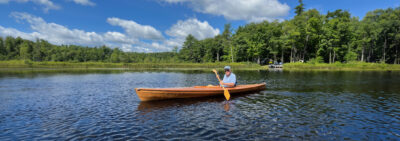
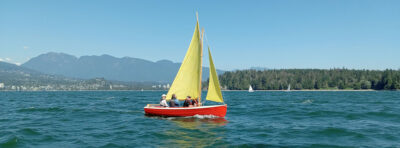

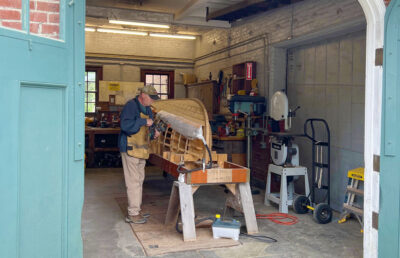
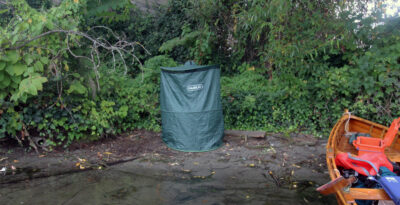


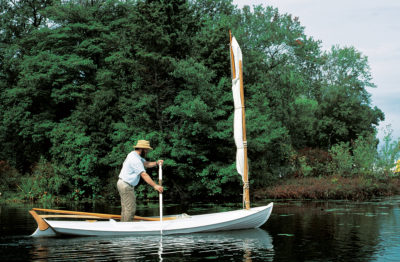
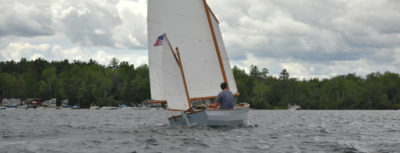
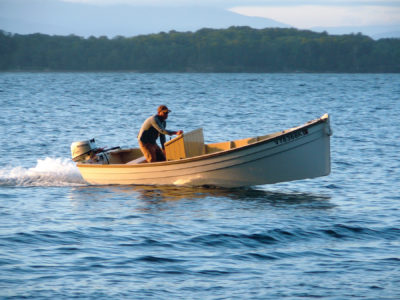
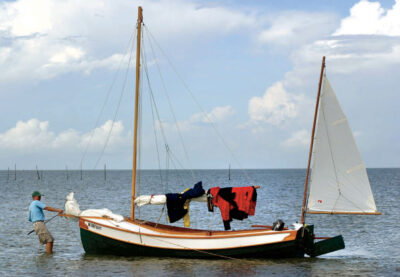
I wondered several ,years ago when David was visiting a maritime client in Seattle if he would address the initial stability issue or was swearing off kayaks forever. I was surprised after paddling with him from Lk Union to dinner at Fisherman’s Terminal in protected waters that David didn’t wish to paddle back. We were in twin 17′ Pygmy Arctic Terns I’d built from kits a few years earlier. His assessment, “Too tippy.”
I should’ve been a bit more attentive as host to my boyhood friend as I had been witness to a climber buddy’s sudden shoulder injury while attempting a quiet riverside launch. And I failed to. inform a son-in-law that kayaks behave differently than canoes (a very quick wet exit).
David’s design solutions (skeg as carry point) are ever a source of, “Why didn’t I think of that?” I carry with me, whenever launching, David’s not original but oft repeated, “the smaller the boat, the greater the fun.” Thanks, Ben, for a terrific review.
Stowing dry bags through cockpit access is a traditional practice. Boats without bulkheads and hatches require it. Besides the inevitable fact that it will be difficult to reach well into the ends of the boat, however, is the risk of having the bags go adrift in case of a capsize. The boat should have some method of securing the bags in place. Even if you should be able to retrieve all the wayward gear, it still would be a challenge to get it stowed properly before reentering the boat.
I paddled with a friend whose boat of choice was a Brose Brothers “Mariner,” a once popular and well-respected kayak out of Seattle. (I remember hearing that the Brose brothers disliked bulkheads and hatches, and would only install them with great reluctance). After one campout, as we were loading up for the next leg, he was almost ready when he discovered a piece of kit that belonged way up forward, which meant he had to unpack everything in order to get that one piece up where it belonged. Of course this can happen with bulkheads and hatches too, but in that case it’s a much less onerous task.
As for spray skirts, I think coastal paddling, where it’s possible to get swept by a breaking wave, absolutely requires them. In other words, the spray skirt is not just for paddle drip.
David, What a graceful and functional beauty! Congratulations on your design that looks like lots of safe fun! And Clint, perhaps you’ll bring one out to the PNW so we can try it?
Slainte,
That would be a good boat to bring out, but I will be flying. It is a great boat…hopefully someone out there will build one.